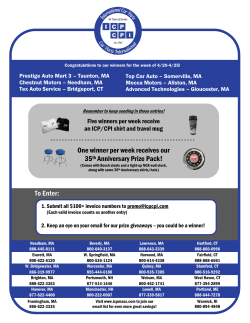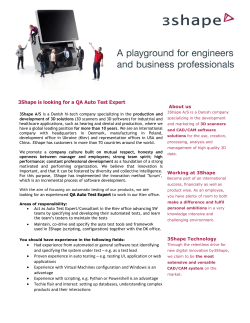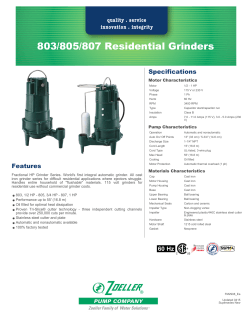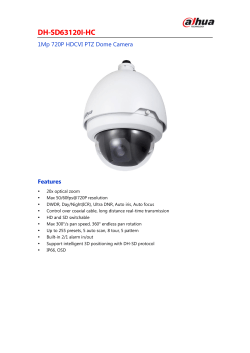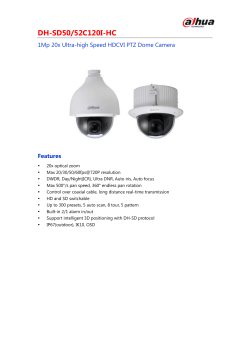
ARK-1 / AR-1
ARK-1 / AR-1 Series Specifications Model Auto refractometer Measurement range Minimum measurable pupil diameter Auto keratometer*1 Measurement range Sagittal measurement VA measurement Measurement mode Measurement range Correction range Vision comparison Retroillumination image Accommodation measurement range PD measurement range Corneal size measurement range*4 Pupil size measurement range Auto tracking / Auto shot Display Printer Interface Power supply Power consumption Dimensions / Mass ARK-1s / AR-1s ARK-1a / AR-1a ARK-1 / AR-1 Not available Not available Available with scenery chart Available*2 / Not available*3 Not available Not available Sphere -30.00 to +25.00 D (VD = 12 mm) (0.01 / 0.12 / 0.25 D increments) Cylinder 0 to ±12.00 D (0.01 / 0.12 / 0.25 D increments) Axis 0 to 180° (1° / 5° increments) ø2 mm Curvature radius 5.00 to 13.00 mm (0.01 mm increments) Refractive power 25.96 to 67.50 D (n = 1.3375) (0.01 / 0.12 / 0.25 D increments) Cylindrical power 0 to ±12.00 D (0.01 / 0.12 / 0.25 D increments) Axis 0 to 180º (1° / 5° increments) 25º each from the center (superior side, inferior side, temporal side, nasal side) Uncorrected VA, Corrected VA (distance, near) Less than 0.1, 0.1, 0.25, 0.32, 0.4, 0.5, 0.63, 0.8, 1.0, 1.25 or Less than 20 / 200, 20 / 200, 20 / 80, 20 / 60, 20 / 50, 20 / 40, 20 / 30, 20 / 25, 20 / 20, 20 / 16 Sphere -20.00 to +20.00 D (VD = 12 mm) (0.25 D increments) Cylinder 0 to ±8.00 D (0.25 D increments) Axis 0 to 180º (1º / 5º increments) Available with VA chart Available 0 to 10.00 D (0.01 / 0.12 / 0.25 D increments) 30 to 85 mm (1 mm increments) (Near point PD: 28 to 80 mm at WD = 40 cm) 10.0 to 14.0 mm (0.1 mm increments) 1.0 to 10.0 mm (0.1 mm increments) X-Y-Z directions Auto shot Tiltable 6.5-inch color LCD Thermal line printer with easy loading and auto cutter RS-232C (in / out), LAN, USB, Eye Care card system*5 AC 100 to 240 V 50 / 60 Hz 100 VA 260 (W) x 495 (D) x 457 (H) mm / 20 kg 10.2 (W) x 19.5 (D) x 18.0 (H)" / 44 lbs. Y direction Auto shot *1 Not available for the AR-1s, AR-1a, and AR-1 *2 Available with scenery chart for the ARK-1 *3 Not available for the AR-1 *4 Not available for the AR-1s, AR-1a, and AR-1 *5 The Eye Care card is optional. Product / Model name: Auto Ref / Keratometer ARK-1s / 1a / 1 Auto Refractometer AR-1s / 1a / 1 Caution: U.S. Federal Law restricts this device to sale, distribution, and use by or on the order of a physician or other licensed eye care practitioner. The NIDEK cataract indices are not available in USA. Specifications may vary depending on circumstances in each country. Specifications and design are subject to change without notice. HEAD OFFICE (International Div.) TOKYO OFFICE (International Div.) 34-14 Maehama, Hiroishi Gamagori, Aichi 443-0038, Japan TEL: +81-533-67-8895 URL: http://www.nidek.co.jp 3F Sumitomo Fudosan Hongo Bldg., 3-22-5 Hongo, Bunkyo-ku, Tokyo 113-0033, Japan TEL: +81-3-5844-2641 URL: http://www.nidek.com NIDEK INC. NIDEK S.A. NIDEK TECHNOLOGIES Srl NIDEK (SHANGHAI) CO., LTD. 47651 Westinghouse Drive Fremont, CA 94539, U.S.A. TEL: +1-510-226-5700 +1-800-223-9044 (US only) URL: http://usa.nidek.com Europarc 13, rue Auguste Perret 94042 Creteil, France TEL: +33-1-49 80 97 97 URL: http://www.nidek.fr Via dell'Artigianato, 6 / A 35020 Albignasego (Padova), Italy TEL: +39 049 8629200 / 8626399 URL: http://www.nidektechnologies.it Rm 915, China Venturetech Plaza, No.819 Nanjing West Rd, Jing An District, Shanghai China 200041 TEL: +86 021-5212-7942 URL: http://www.nidek-china.cn NIDEK SINGAPORE PTE. LTD. 51 Changi Business Park Central 2 #06-14 The Signature Singapore 486066 TEL: +65 6588 0389 [ Manufacturer ] CNIDEK 2013 Printed in Japan ARK-1 / AR-1 3 Auto Ref / Keratometer / Auto Refractometer ARK-1 / AR-1 The Superior Auto Ref Re / Keratometer and Auto Refractometer What is the superior auto ref / keratometer and auto refractometer? The ARK-1 / AR-1 series speak for themselves, surpassing a conventional auto ref / keratometer and auto refractometer with technologically enhanced functions generating greater accuracy and greater clinical information. Superior Function Functions fo for Superior Outcomes Accurate Refraction Measurement Easy VA Measurement with Glare Test Simple Opacity Assessment Patient-friendly Accommodation Measurement Model Refraction measurement Keratometry measurement VA measurement Glare test Opacity assessment Accommodation measurement ARK-1s ○ ○ ○ ○ ○ ARK-1a ○ ○ ○ ○ ARK-1 ○ ○ AR-1s ○ ○ ○ AR-1a ○ ○ ○ AR-1 ○ ○ - Available - Not available ○ The Superior Auto Ref Re / Keratometer and Auto Refractometer What is the superior auto ref / keratometer and auto refractometer? The ARK-1 / AR-1 series speak for themselves, surpassing a conventional auto ref / keratometer and auto refractometer with technologically enhanced functions generating greater accuracy and greater clinical information. Superior Function Functions fo for Superior Outcomes Accurate Refraction Measurement Easy VA Measurement with Glare Test Simple Opacity Assessment Patient-friendly Accommodation Measurement Model Refraction measurement Keratometry measurement VA measurement Glare test Opacity assessment Accommodation measurement ARK-1s ○ ○ ○ ○ ○ ARK-1a ○ ○ ○ ○ ARK-1 ○ ○ AR-1s ○ ○ ○ AR-1a ○ ○ ○ AR-1 ○ ○ - Available - Not available ○ Accurate Refraction Measurement VA Measurement with Glare Test Large Pupil Zone Imaging Method VA Measurement with Built-in Charts and Lenses (available for the ARK-1s and AR-1s) The large pupil zone imaging method enables the measurement of wide area refraction of up to 6 mm diameter and can indicate the difference between wide area refraction and the central area refraction of up to 3.5 mm diameter. The pupil diameter is measured simultaneously. The difference of the measurement allows assessment of the effect of pupil size such as a vision in dim light. The ARK-1s / AR-1s provides visual acuity (VA) measurement. This unique function enables a quick check of the patient's refractive error by comparing subjective measurement with objective measurement. Even corrected near visual acuity is measurable with easy operability to determine the need for a progressive lens. ø1 to 3.5 mm area ø1 to 4 mm area ø1 to 6 mm area Recall Function for Instant Vision Comparisons (available for the ARK-1s / 1a / 1 and AR-1s / 1a) The recall function provides the instant comparison between vision corrected with AR data and uncorrected vision or vision corrected with the data of patient’s own glasses. For the patient, this function demonstrates the difference in vision and the necessity for more appropriate vision correction. Ring image Ring image ARK-500 / AR-300 series ARK-1 / AR-1 series Pupil zone imaging method Large pupil zone imaging method Distance vision corrected with AR data Near vision corrected with AR data Uncorrected distance vision Distance vision corrected with LM data* Uncorrected near vision Near vision corrected with LM data* *The data of patient’s own glasses has to be imported from a NIDEK lensmeter. Vision comparisons Contrast and Glare Test (available for the ARK-1s and AR-1s) Super Luminescent Diode and Highly Sensitive CCD Incorporation of the Super Luminescent Diode (SLD) provides a sharper and clearer image compared to a conventional LED. The highly sensitive CCD detects the ring image even if the fundus reflection is weak. The system combining the SLD and highly sensitive CCD significantly improves measurement capability even in dense cataractous eyes. Hyperopia Emmetropia Myopia After a low contrast VA chart is projected, a glare source is projected beside the chart and the glare VA can be measured. With this test the effect of glare and halo to visual performance can be measured. This utility can be used for cataract and refractive surgery patients. Simulated patient’s vision of low contrast VA chart Vision with glare and halo Normal vision Simulated patient vision of VA chart and glare source Half mirror Astigmatism Eye Astigmatism Simulated ring image SLD (normal eye) LED (normal eye) Keratometry Measurement with Mire Ring (available for the ARK-1s, ARK-1a, and ARK-1) Reflective mirror The mire ring is used to measure keratometry. It reduces eyelid artifacts. Ring lens Emitted SLD light Reflected light Ring image SLD SLD (cataractous eye)* Highly sensitive CCD LED (cataractous eye)* Captured ring image * In-house data of a cataractous model eye Measurement with four points Optimal Fogging to Minimize Accommodation (available for the ARK-1s / 1a and AR-1s / 1a) Fogging is performed after correcting the patient’s astigmatism with built-in cylinder lenses. This allows the patient to view the target clearly and minimizes the interference with accommodation even in high astigmatism. Measurement with mire ring Accurate Refraction Measurement VA Measurement with Glare Test Large Pupil Zone Imaging Method VA Measurement with Built-in Charts and Lenses (available for the ARK-1s and AR-1s) The large pupil zone imaging method enables the measurement of wide area refraction of up to 6 mm diameter and can indicate the difference between wide area refraction and the central area refraction of up to 3.5 mm diameter. The pupil diameter is measured simultaneously. The difference of the measurement allows assessment of the effect of pupil size such as a vision in dim light. The ARK-1s / AR-1s provides visual acuity (VA) measurement. This unique function enables a quick check of the patient's refractive error by comparing subjective measurement with objective measurement. Even corrected near visual acuity is measurable with easy operability to determine the need for a progressive lens. ø1 to 3.5 mm area ø1 to 4 mm area ø1 to 6 mm area Recall Function for Instant Vision Comparisons (available for the ARK-1s / 1a / 1 and AR-1s / 1a) The recall function provides the instant comparison between vision corrected with AR data and uncorrected vision or vision corrected with the data of patient’s own glasses. For the patient, this function demonstrates the difference in vision and the necessity for more appropriate vision correction. Ring image Ring image ARK-500 / AR-300 series ARK-1 / AR-1 series Pupil zone imaging method Large pupil zone imaging method Distance vision corrected with AR data Near vision corrected with AR data Uncorrected distance vision Distance vision corrected with LM data* Uncorrected near vision Near vision corrected with LM data* *The data of patient’s own glasses has to be imported from a NIDEK lensmeter. Vision comparisons Contrast and Glare Test (available for the ARK-1s and AR-1s) Super Luminescent Diode and Highly Sensitive CCD Incorporation of the Super Luminescent Diode (SLD) provides a sharper and clearer image compared to a conventional LED. The highly sensitive CCD detects the ring image even if the fundus reflection is weak. The system combining the SLD and highly sensitive CCD significantly improves measurement capability even in dense cataractous eyes. Hyperopia Emmetropia Myopia After a low contrast VA chart is projected, a glare source is projected beside the chart and the glare VA can be measured. With this test the effect of glare and halo to visual performance can be measured. This utility can be used for cataract and refractive surgery patients. Simulated patient’s vision of low contrast VA chart Vision with glare and halo Half mirror Astigmatism Eye Astigmatism Simulated ring image SLD (normal eye) LED (normal eye) Keratometry Measurement with Mire Ring (available for the ARK-1s / 1a / 1) Reflective mirror The mire ring is used to measure keratometry. It reduces eyelid artifacts. Ring lens Emitted SLD light Reflected light Ring image SLD SLD (cataractous eye)* Highly sensitive CCD LED (cataractous eye)* Captured ring image * In-house data of a cataractous model eye Measurement with four points Optimal Fogging to Minimize Accommodation (available for the ARK-1s / 1a and AR-1s / 1a) Fogging is performed after correcting the patient’s astigmatism with built-in cylinder lenses. This allows the patient to view the target clearly and minimizes the interference with accommodation even in high astigmatism. Normal vision Simulated patient vision of VA chart and glare source Measurement with mire ring Practical and User-friendly Features Patient-friendly Accommodation Measurement (available for the ARK-1s / 1a and AR-1s / 1a) Accommodation Measurement with Artificial Intelligence Algorithm Objective measurement of accommodation is performed with patient’s focusing on a target which moves from distance to near. The artificial intelligence algorithm detects the patient’s response and reduces the measurement time in cases with a slow or weak accommodative response. The accommodation measurement helps to assess pseudomyopia, eyestrain, and accommodative palsy. Amplitude of accommodation Accommodation graph Pupil diameter graph Astigmatism is corrected with built-in cylinder lenses prior to measurement. It reduces the influence of astigmatism on the measurement of accommodation. Assessment for Intermediate or Near Vision Lens The assessment of accommodation based on the age-accommodation relation allows to suggest whether an intermediate or near lens is required. Amplitude of accommodation (D) Measurement with Astigmatism Correction 14 12 10 8 6 4 2 0 3-D* Auto Tracking and Auto Shot Tiltable Color LCD Screen High Speed Printer with Easy Loading & Auto Cutter The 3-D auto tracking and auto shot provide faster, simpler, and more accurate measurements. When alignment is performed correctly, measurement starts automatically. The color LCD with tilt function offers easy operation even when an operator is standing. The printer paper can be changed easily. The data sheet is cut by an auto cutter for quick and easy detachment. *Y direction (vertical) auto tracking is available for the ARK-1 and AR-1. 0 10 20 30 40 50 60 70 80 Age (year) Courtesy of Masayoshi Kajita, MD, PhD The amplitudes of accommodation on the graph are values of subjective measurement. The amplitudes of accommodation of objective measurement tend to be lower than those on the graph. Simple Opacity Assessment Summary Display of Measured Value Eye Care Card System* Various measured values can be displayed simultaneously on the summary screen allowing easy and quick confirmation and printing. A card slot enables the use of an Eye Care card system, which provides quick and easy wireless data transfer. *The card is optional. Retroillumination Image and NIDEK Cataract Indices* The retro illumination image enables the observation of opacity of the optical media of the eye. NIDEK cataract indices indicate the severity of the opacity and helps to assess the progression of pathology. COI.H Opacity size within a diameter of 3 mm of the center (vertical diameter): mm COI.A Opacity proportion within a diameter of 3 mm of the center: % POI Eye with dense opacity Opacity proportion within the entire periphery: % Eye Care Card System Cataract indices *Available for the ARK-1s / 1a and AR-1s / 1a The NIDEK Cataract indices are for reference only. The following conditions may indicate different indices from ones of actual status. Peripheral image is darkly captured due to alignment position. Opacities are not in focus. Bright spot reflecting observation light occurs on the cornea apex. Position of the 3 mm diameter circle is shifted due to incorrect pupil detection caused by opacity location. Eye with light opacity Practical and User-friendly Features Patient-friendly Accommodation Measurement (available for the ARK-1s / 1a and AR-1s / 1a) Accommodation Measurement with Artificial Intelligence Algorithm Objective measurement of accommodation is performed with patient’s focusing on a target which moves from distance to near. The artificial intelligence algorithm detects the patient’s response and reduces the measurement time in cases with a slow or weak accommodative response. The accommodation measurement helps to assess pseudomyopia, eyestrain, and accommodative palsy. Amplitude of accommodation Accommodation graph Pupil diameter graph Astigmatism is corrected with built-in cylinder lenses prior to measurement. It reduces the influence of astigmatism on the measurement of accommodation. Assessment for Intermediate or Near Vision Lens The assessment of accommodation based on the age-accommodation relation allows to suggest whether an intermediate or near lens is required. Amplitude of accommodation (D) Measurement with Astigmatism Correction 14 12 10 8 6 4 2 0 3-D* Auto Tracking and Auto Shot Tiltable Color LCD Screen High Speed Printer with Easy Loading & Auto Cutter The 3-D auto tracking and auto shot provide faster, simpler, and more accurate measurements. When alignment is performed correctly, measurement starts Y direction automatically. The color LCD with tilt function offers easy operation even when an operator is standing. The printer paper can be changed easily. The data sheet is cut by an auto cutter for quick and easy detachment. *Y direction (vertical) auto tracking is FOCUS available for the ARK-1 and AR-1. 0 X direction 10 20 30 40 50 60 70 80 Age (year) Courtesy of Masayoshi Kajita, MD, PhD The amplitudes of accommodation on the graph are values of subjective measurement. The amplitudes of accommodation of objective measurement tend to be lower than those on the graph. Simple Opacity Assessment Summary Display and Printout of Measured Values Eye Care Card System* Various measured values can be displayed simultaneously on the summary screen allowing easy and quick confirmation and printing. A card slot enables the use of an Eye Care card system, which provides quick and easy wireless data transfer. *The card is optional. Retroillumination Image and NIDEK Cataract Indices* The retro illumination image enables the observation of opacity of the optical media of the eye. NIDEK cataract indices indicate the severity of the opacity and helps to assess the progression of pathology. COI.H Opacity size within a diameter of 3 mm of the center (vertical diameter): mm COI.A Opacity proportion within a diameter of 3 mm of the center: % POI Eye with dense opacity Opacity proportion within the entire periphery: % Eye Care Card System Cataract indices *Available for the ARK-1s / 1a and AR-1s / 1a The NIDEK Cataract indices are for reference only. The following conditions may indicate different indices from ones of actual status. Peripheral image is darkly captured due to alignment position. Opacities are not in focus. Bright spot reflecting observation light occurs on the cornea apex. Position of the 3 mm diameter circle is shifted due to incorrect pupil detection caused by opacity location. Eye with light opacity ARK-1 / AR-1 Series Specifications Model Auto refractometer Measurement range Minimum measurable pupil diameter Auto keratometer*1 Measurement range Sagittal measurement VA measurement Measurement mode Measurement range Correction range Vision comparison Retroillumination image Accommodation measurement range PD measurement range Corneal size measurement range*4 Pupil size measurement range Auto tracking Auto shot Display Printer Interface Power supply Power consumption Dimensions / Mass ARK-1s / AR-1s ARK-1a / AR-1a ARK-1 / AR-1 Not available Not available Available with scenery chart Available*2 / Not available*3 Not available Not available Sphere -30.00 to +25.00 D (VD = 12 mm) (0.01 / 0.12 / 0.25 D increments) Cylinder 0 to ±12.00 D (0.01 / 0.12 / 0.25 D increments) Axis 0 to 180° (1° / 5° increments) ø2 mm Curvature radius 5.00 to 13.00 mm (0.01 mm increments) Refractive power 25.96 to 67.50 D (n = 1.3375) (0.01 / 0.12 / 0.25 D increments) Cylindrical power 0 to ±12.00 D (0.01 / 0.12 / 0.25 D increments) Axis 0 to 180º (1° / 5° increments) 25º each from the center (superior side, inferior side, temporal side, nasal side) Uncorrected VA, Corrected VA (distance, near) Less than 0.1, 0.1, 0.25, 0.32, 0.4, 0.5, 0.63, 0.8, 1.0, 1.25 or Less than 20 / 200, 20 / 200, 20 / 80, 20 / 60, 20 / 50, 20 / 40, 20 / 30, 20 / 25, 20 / 20, 20 / 16 Sphere -20.00 to +20.00 D (VD = 12 mm) (0.25 D increments) Cylinder 0 to ±8.00 D (0.25 D increments) Axis 0 to 180º (1º / 5º increments) Available with VA chart Available 0 to 10.00 D (0.01 / 0.12 / 0.25 D increments) 30 to 85 mm (1 mm increments) (Near point PD: 28 to 80 mm at WD = 40 cm) 10.0 to 14.0 mm (0.1 mm increments) 1.0 to 10.0 mm (0.1 mm increments) X-Y-Z directions Available Tiltable 6.5-inch color LCD Thermal line printer with easy loading and auto cutter RS-232C (in / out), LAN, USB, Eye Care card system*5 AC 100 to 240 V 50 / 60 Hz 100 VA 260 (W) x 495 (D) x 457 (H) mm / 20 kg 10.2 (W) x 19.5 (D) x 18.0 (H)" / 44 lbs. Y direction *1 Not available for the AR-1s, AR-1a, and AR-1 *2 Available with scenery chart for the ARK-1 *3 Not available for the AR-1 *4 Not available for the AR-1s, AR-1a, and AR-1 *5 The Eye Care card is optional. Product / Model name: Auto Ref / Keratometer ARK-1s / 1a / 1 Auto Refractometer AR-1s / 1a / 1 Caution: U.S. Federal Law restricts this device to sale, distribution, and use by or on the order of a physician or other licensed eye care practitioner. The NIDEK cataract indices are not available in USA. Specifications may vary depending on circumstances in each country. Specifications and design are subject to change without notice. HEAD OFFICE (International Div.) TOKYO OFFICE (International Div.) 34-14 Maehama, Hiroishi Gamagori, Aichi 443-0038, Japan TEL: +81-533-67-8895 URL: http://www.nidek.co.jp 3F Sumitomo Fudosan Hongo Bldg., 3-22-5 Hongo, Bunkyo-ku, Tokyo 113-0033, Japan TEL: +81-3-5844-2641 URL: http://www.nidek.com NIDEK INC. NIDEK S.A. NIDEK TECHNOLOGIES Srl NIDEK (SHANGHAI) CO., LTD. 47651 Westinghouse Drive Fremont, CA 94539, U.S.A. TEL: +1-510-226-5700 +1-800-223-9044 (US only) URL: http://usa.nidek.com Europarc 13, rue Auguste Perret 94042 Creteil, France TEL: +33-1-49 80 97 97 URL: http://www.nidek.fr Via dell'Artigianato, 6 / A 35020 Albignasego (Padova), Italy TEL: +39 049 8629200 / 8626399 URL: http://www.nidektechnologies.it Rm 915, China Venturetech Plaza, No.819 Nanjing West Rd, Jing An District, Shanghai China 200041 TEL: +86 021-5212-7942 URL: http://www.nidek-china.cn NIDEK SINGAPORE PTE. LTD. 51 Changi Business Park Central 2 #06-14 The Signature Singapore 486066 TEL: +65 6588 0389 [ Manufacturer ] CNIDEK 2013 Printed in Japan ARK-1 / AR-1 3 Auto Ref / Keratometer / Auto Refractometer ARK-1 / AR-1
© Copyright 2025


